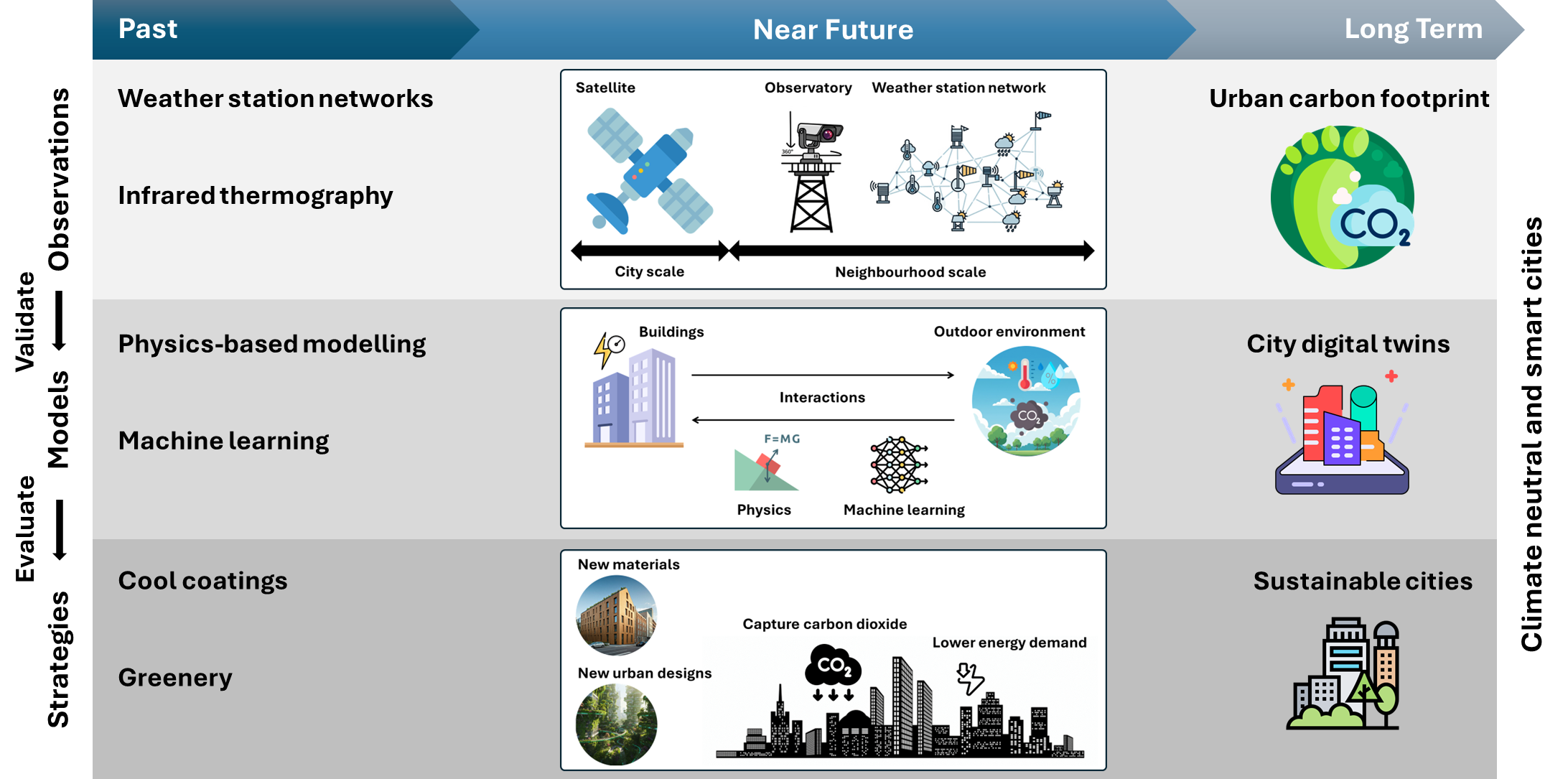To date, my research has primarily focused on building energy performance and urban overheating, utilizing physics-based models of thermal interactions between buildings and their outdoor environment. In light of findings reported in various studies12, I have come to realize that urban decarbonization must extend beyond building energy performance to tackle climate change. Through my participation in the PLEA 2024 conference and review of recent scientific contributions in urban sustainability 34, I have come to understand that new building materials and urban designs possess the potential to transform cities into carbon sinks. Although carbon sink strategies offer new perspectives to accelerate urban decarbonization, I observed that limited data and simulation tools are available for assessing their efficacy in capturing carbon dioxide in the outdoor air. This observation enabled me to sharpen my research vision on urban sustainability around three pillars:
- Developing novel monitoring approaches, drawing on my expertise in large sensor networks and thermal cameras, to detect sources and sinks of heat and carbon dioxide at multiple scales within a city;
- Leveraging physics-based modeling and machine learning to accurately and effectively simulate thermal and carbon interactions between buildings and their outdoor environments at multiple scales, in different climates, and for various applications; and
- Utilizing data and models to assess the capabilities of new building materials and urban designs in reducing energy consumption in cities and transforming them into carbon sinks.
The figure below depicts my research vision, which builds upon my past research and charts a path toward becoming a leading expert in climate-neutral and smart cities.

Liang, Y., Li, C., Liu, Z., Wang, X., Zeng, F., Yuan, X., & Pan, Y. (2023). Decarbonization potentials of the embodied energy use and operational process in buildings: A review from the life-cycle perspective. Heliyon, 9(10). ↩︎
Rockstrom, J., Gaffney, O., Rogelj, J., Meinshausen, M., Nakicenovic, N., & Schellnhuber, H. J. (2017). A roadmap for rapid decarbonization. Science, 355(6331), 1269-1271. ↩︎
Churkina, G., Organschi, A., Reyer, C. P., Ruff, A., Vinke, K., Liu, Z., … & Schellnhuber, H. J. (2020). Buildings as a global carbon sink. Nature sustainability, 3(4), 269-276. ↩︎
Velasco, E., Roth, M., Norford, L., & Molina, L. T. (2016). Does urban vegetation enhance carbon sequestration?. Landscape and urban planning, 148, 99-107. ↩︎
Monitor urban overheating and carbon dioxide
For the past five years, I have studied monitoring approaches to observe factors contributing to and mitigating urban overheating. During my tenure at a collaborative research alliance between the University of California Berkeley (UCB) and the National University of Singapore (NUS), I reviewed approaches relying on infrared thermography1 and established Singapore’s first rooftop observatory for neighborhood-scale studies2. The rooftop observatory served as the foundation for a project administered by NUS, in which I participate as a research collaborator (see the link here). It was also used as a reference to collect thermal images of the outdoor built environment at the Carnegie Mellon University (CMU) campus (see the link here). My expertise in monitoring urban overheating is currently being sought by Rowan Williams Davis and Irvin Inc..
Building on this expertise, my objective is to observe urban carbon sources and sinks. I plan to deploy large sensor networks to analyze carbon concentration in several built environments. While valuable, sensor networks are one of many monitoring approaches. To enhance multiscale observations, I intend to explore approaches using satellites and mobile systems as well. Multiscale observations of urban carbon sources and sinks could be used for a better assessment of urban carbon footprint in future investigations3.
Martin, M., Chong, A., Biljecki, F., & Miller, C. (2022). Infrared thermography in the built environment: A multi-scale review. Renewable and sustainable energy reviews, 165, 112540. ↩︎
Martin, M., Ramani, V., & Miller, C. (2024). InfraRed Investigation in Singapore (IRIS) Observatory: Urban heat island contributors and mitigators analysis using neighborhood-scale thermal imaging. Energy and Buildings, 307, 113973. ↩︎
Lombardi, M., Laiola, E., Tricase, C., & Rana, R. (2017). Assessing the urban carbon footprint: An overview. Environmental Impact Assessment Review, 66, 43-52. ↩︎
Model thermal and carbon interactions
In addition to observing urban carbon sources and sinks, I suggest to develop novel models of carbon exchanges between buildings and their outdoor environments, which will extend my previous work on physics-based thermal interaction modeling conducted at the Masdar Institute of Science and Technology (MIST) and NUS 1 2 3 4. To address the computational cost and parameter complexity of physics-based models 5, I collaborated with CMU on machine learning. While faster and simpler, machine learning requires extensive training data and lack interpretability 6 7. My current research aims to determine the scales, climates, and applications for which physics-based models and/or machine learning are suitable for simulations of thermal interactions. Among applications, city digital twins are certainly of the most significant interest to industry leaders and policy makers.
Existing models, whether based on physics or machine learning, have focused on thermal interactions 5, sufficient for building energy and urban overheating studies, but inadequate for complete decarbonization analysis. To address this gap, models should incorporate carbon exchanges between buildings and their outdoor environment. As a first step, I am developing an urban building energy model that serves as input for computational fluid dynamics to simulate carbon dispersion within the urban canopy. The next step is to determine whether carbon exchange can be accurately simulated using simplified physics and machine learning. Similar to thermal interactions, the accuracy and performance of carbon exchange models should be assessed across various scales and within different climates.
Martin, M., Afshari, A., Armstrong, P. R., & Norford, L. K. (2015). Estimation of urban temperature and humidity using a lumped parameter model coupled with an EnergyPlus model. Energy and Buildings, 96, 221-235. ↩︎
Martin, M., Afshari, A., Armstrong, P. R., & Norford, L. K. (2016). A new validation protocol for an urban microclimate model based on temperature measurements in a Central European city. Energy and Buildings, 114, 38-53. ↩︎
Martin, M., Wong, N. H., Hii, D. J. C., & Ignatius, M. (2017). Comparison between simplified and detailed EnergyPlus models coupled with an urban canopy model. Energy and Buildings, 157, 116-125. ↩︎
Miguel, M., Hien, W. N., Marcel, I., Chung, H. D. J., Yueer, H., Zhonqi, Y., … & Son, N. N. (2021). A physically-based model of interactions between a building and its outdoor conditions at the urban microscale. Energy and Buildings, 237, 110788. ↩︎
Sezer, N., Yoonus, H., Zhan, D., Wang, L. L., Hassan, I. G., & Rahman, M. A. (2023). Urban microclimate and building energy models: A review of the latest progress in coupling strategies. Renewable and Sustainable Energy Reviews, 184, 113577. ↩︎ ↩︎
Manfren, M., James, P. A., & Tronchin, L. (2022). Data-driven building energy modelling–An analysis of the potential for generalisation through interpretable machine learning. Renewable and Sustainable Energy Reviews, 167, 112686. ↩︎
Wang, H., Yang, J., Chen, G., Ren, C., & Zhang, J. (2023). Machine learning applications on air temperature prediction in the urban canopy layer: A critical review of 2011–2022. Urban Climate, 49, 101499. ↩︎
Evaluate decarbonization strategies
Models of thermal and carbon interactions between buildings and their outdoor environment offer a promising perspective for evaluating strategies that reduce building energy consumption and increase urban carbon sequestration. They can thus form the basis of support tools for scientists, industry leaders, and policymakers to create a comprehensive city decarbonization roadmap aligned with Paris Agreement targets. To develop such tools and become a world leader in climate-neutral and smart cities, I am seeking research collaborations. My initial objective is to collaborate with Building Material Science researchers to quantify the potential for carbon sequestration by timber and innovative building materials. Subsequently, I intend to collaborate with Urban Planning experts to investigate urban design strategies that incorporate vegetation for maximized outdoor thermal comfort and carbon sequestration.
Beyond urban sustainability, I aim to achieve scientific recognition in the field of building heat resilience. According to Hong et al. 1, achieving building heat resilience demands knowledge across Energy Systems and Human Behavior, in addition to understanding thermal interactions between buildings and their outdoor environment. For this reason, I would welcome the opportunity to collaborate with specialists in these two fields.
Hong, T., Malik, J., Krelling, A., O’brien, W., Sun, K., Lamberts, R., & Wei, M. (2023). Ten questions concerning thermal resilience of buildings and occupants for climate adaptation. Building and Environment, 244, 110806. ↩︎
